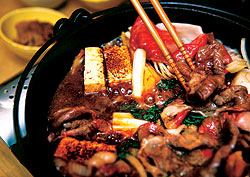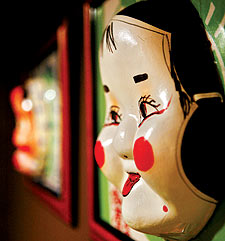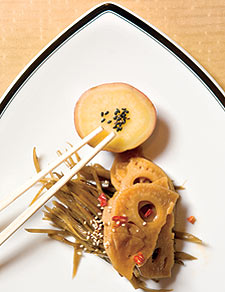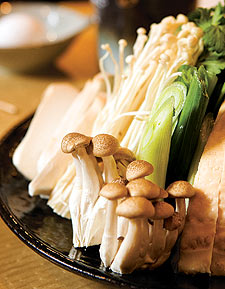If ever there were two restaurants that deserved more business, Chiyo Japanese Restaurant in Albany Park and Mulan in Chinatown head up the list. Why these two have been neglected is beyond me: both offer one-of-a-kind Asian meals. Chiyo delivers the kind of dining experience you might find on a Tokyo side street, and Mulan drives New American fusion into uncharted Eastern territory. I suspect if either restaurant were situated in River North, the fashionistas would be waiting two-deep for a table. Chiyo is the reincarnated Matsumoto, now named after Chiyo Tozuka, who owns the restaurant with her husband, Isao. The former kaiseki dinner (chef’s tasting menu) that Matsumoto was known for is still available ($80 with five days’ advance notice), but the new emphasis is on more accessible shabu-shabu (similar to Chinese hot pots) and sukiyaki (stir-fried, bite-size pieces of meat, vegetables, noodles, and tofu) supplemented with ippin ryori, the Japanese equivalent of tapas.
The storefront, located on a forgotten stretch of Albany Park, has been remodeled and looks great. There are half a dozen tables in the main room, the best separated from the sushi bar by ceiling-to-floor tassels that provide semi-privacy. Two truly private rooms-waitresses call them booths-with brick walls and chandeliers are furnished with tables whose bare tops look like laminated bamboo screens; they’re set with amusing chopstick holders in the shape of raccoons with rolling eyes. The level of service-led by the friendly, kinetic Chiyo and a couple of kimono-clad waitresses-is nothing short of amazing, although I have no idea what it would be like if there were more than one or two other parties in the place. There never seem to be. Chef Isao’s selection of about three dozen ippin ryori range from the expected-pristine goma-ae (cooked spinach with sesame dressing), crisp tempura, and tonkatsu (breaded and fried pork cutlet), juicy chicken teriyaki-to the utterly unusual. Kimpira is fresh, flavorful, and healthful: a beautiful triangular plate of soy-marinated and chili-spiked lotus root wheels and burdock root strips with a piece of sesame seed–sprinkled Japanese sweet potato. Ika (squid) and kinoko (mushrooms, here a mix of enoki, oyster, shimeji, and shiitake) sliced into strips bathe in a light soy and mirin sauce with a little spice kick and lots of delicate flavor. If you miss foie gras, look into the ann-kimo, an awesome treat of Cognac-flavored poached monkfish liver served in a martini glass with pickle garnish-smooth and decadent. Sushi is not the main event at Chiyo, but the sashimi and sushi are first-rate, served with thick homemade soy sauce. Saké makes the perfect accompaniment for ippin ryori or sushi, and the owners take it seriously, offering 30 varieties, most by the bottle or glass. I loved the refreshing Aoinikko Junmai, one of the less expensive choices at $38 a bottle (or $7.20 by the glass).
If you want to really eat like the Japanese, shabu-shabu or sukiyaki (two diner minimum) is the way to go. You can get them with wagyu beef (a Japanese breed of cattle that produces densely marbled beef) air-freighted from Japan ($90 per person), Kobe beef (here, the American version of wagyu) raised in Washington ($49), or prime beef ($39). I tried shabu-shabu with wagyu, which has seed-size particles of fat embedded throughout the lean meat, giving it the color and texture of tuna. I couldn’t believe it came from a cow. The Kobe had marbling in bigger patches and was less delicate-but also delicious. Our waitress cheerfully guided us through the ritual, bringing first a burner and a hammered copper shabu-shabu pot and then platters of thinly sliced beef and equally enticing vegetables: four kinds of mushrooms, glass taro noodles, Chinese cabbage, chrysanthemums, and scallions. Wielding chopsticks the size of Harry Potter’s wand (“so you won’t burn yourself”), our server demonstrated how to swirl the meat in the light stock while saying “shabu-shabu” two to four times to regulate how long you want it cooked (trust me: less is more) along with the vegetables. Two dipping sauces, a creamy miso-sesame for the meat and homemade ponzu for the vegetables, added final bursts of flavor. After she cooked a few morsels and my companions and I took over, we realized that even we couldn’t screw up beef this good.
The sukiyaki, also cooked at the table, was vastly better than the usual perfunctory version served at sushi joints: it’s not often you get a homemade sukiyaki sauce this light and sweet, nor an equally terrific fresh vegetable array. And the lower-cost prime beef worked great with the more assertive sukiyaki seasoning. Yes, the prices can be painful. But the pain is eased by generous portions, extremely high-quality ingredients, and the inclusion of all kinds of bonuses: an excellent sashimi appetizer (ours was tuna and flounder), rice, and fine miso soup. Fumiki Ichikawa’s sweets hold their own on this serious menu. My favorites were black sesame paste pudding and a slightly less exotic pumpkin crème brûlée topped with a scoop of pumpkin ice cream and sliced persimmons. After polishing off both, a colleague exulted that Chiyo was “a hidden treasure.” I agree. Maybe it’s too well hidden for its own good. —
Mulan looks totally out of place among the tin-shuttered storefronts up on the second level of Chinatown Mall’s underdeveloped east end. The cool décor of the L-shaped restaurant is a study in colorful light fixtures amid dark woods, including panels of neon lights flanking the open kitchen and floating free-form ceiling illumination. The effect is heightened by mirrors in brushed stainless steel frames. The cement floor is painted so as to look like giant aqua and brown puzzle pieces, and comfortable dark banquettes are furnished with high-style inverted wine carafes on a metal stand. Chef/partner Kee Chan, who made a big splash when he opened Heat in 2000, designed the place, so it’s apropos that his everchanging menu is pretty much out there in his experimental ingredient combinations. He smashes together Chinese, Japanese, and Western cuisines-with more intriguing hits than misses. I loved appetizers of spinach udon noodles topped with a rich creamy crab sauce, and the juicy tiger shrimp, each attractively curled around a green bean, served on mixed greens with coconut crème dressing. Cilantro-leek soup sported a delicious dark broth but, the two tiny shelled mussels seemed stingy. The chef consistently pairs meat and seafood in his entrées. Chinatown has never seen anything like grilled New Zealand elk topped with panko-crusted scallops-my favorite exotic surf and turf combo. The game was perfectly browned outside and rich and medium rare inside; the lightly browned scallops lined up on the meat were pierced with dramatic, thin threads of fried tofu. It was served with carrot-coconut miso sauce with chunks of braised carrots-a resounding success. But Australian lamb rack with a shrimp bun on blue cheese miso and port–citron tea sauces was a mixed bag. Scrape off the unpleasant whole black peppercorns and you’ll discover delicious roasted lamb. But there’s nothing you can do about the shrimp bun, which was just hard bread with no discernible shrimp, nor the oversalted miso sauce with minimal blue cheese flavor. Peking duck breast was bland compared to the real thing, served French style in medium rare slices next to a mound of won ton noodles and enoki mushrooms with krill (comparable to baby shrimp) sauce. Pretty, but the plankton-size shrimp in the creamy sauce seemed like krill overkill: not much taste and apparently added to satisfy the chef’s theme of meat with seafood. From a highly international list of a dozen wines, we ordered a nice medium-dry Israeli Yarden riesling ($30) to match the seafood, and a delicious and complex 2002 Glen Carlou South African Meritage blend ($32) for the meat side. Desserts are typically daring. Coconut milk and lemongrass panna cotta was dense and gelatinous but with pleasant Asian flavors and a winning dark cherry saké soup surrounding it; macha green tea cheesecake came with good panko banana fritters and tangy wasabi syrup. This ain’t a Chinese mooncake. Mulan-a most un-Chinatown Chinatown restaurant-looks great and has exciting food with real potential, but there are so few customers even on a Saturday night that monks could convene for meditation in the dining room. Perhaps the owners are holding on until the downstairs lounge opens, in hopes that it will attract a trendy crowd. As with Chiyo, if you must pretend you are in a hip neighborhood, fine, but go to these restaurants. CHIYO JAPANESE RESTAURANT- 3800 West Lawrence Avenue. Appetizers $6 to $15; entrées $18 to $90; desserts $5.50. Dinner Wednesday to Monday. Closed Tuesday. Reservations: 773-267-1555. MULAN- 2017 South Wells Street, Chinatown Square’s East Gate. Appetizers $6 to $8; entrées $16 to $18; desserts $5. Tasting menu $35 to $100. Lunch and dinner daily. Brunch Saturday and Sunday. Reservations: 312-842-8282. |
||||||







